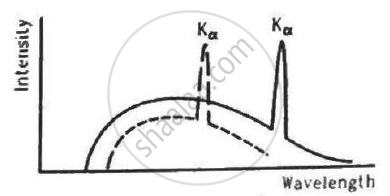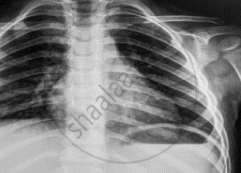Advertisements
Advertisements
प्रश्न
Find the cutoff wavelength for the continuous X-rays coming from an X-ray tube operating at 30 kV.
(Use Planck constant h = 4.14 × 10-15 eVs, speed of light c = 3 × 108 m/s.)
उत्तर
Given:
Voltage of the X-ray tube, V = 30 kV
Cutoff wavelength for continuous X-rays (λ) is given by
`λ = (hc)/(eV)`
Here ,
h = Planck's constant
V = Voltage of the X-ray tube
c = Speed of light
`therefore lambda = (1242 "eV"-"nm")/(e xx 30 xx 10^3)`
⇒ `lambda = 414 xx 10^-4 "nm" = 41.4 "pm"`
APPEARS IN
संबंधित प्रश्न
Identify the part of the electromagnetic spectrum which is:
produced by bombarding a metal target by high speed electrons.
A radio can tune in to any station in the 7.5 MHz to 12 MHz band. What is the corresponding wavelength band?
Give the range of wavelength of the electromagnetic waves visible to us.
Name the radiations of wavelength just shorter than 4 × 10-7 m.
Name the rays or waves of highest frequency .
What are ultraviolet radiations?
The energy of a photon of a characteristic X-ray from a Coolidge tube comes from
The figure shows the intensity-wavelength relations of X-rays coming from two different Coolidge tubes. The solid curve represents the relation for the tube A in which the potential difference between the target and the filament is VA and the atomic number of the target material is ZA. These quantities are VB and ZB for the other tube. Then,

Consider a photon of continuous X-ray and a photon of characteristic X-ray of the same wavelength. Which of the following is/are different for the two photons?
The X-ray coming from a Coolidge tube has a cutoff wavelength of 80 pm. Find the kinetic energy of the electrons hitting the target.
(Use Planck constant h = 6.63 × 10-34 Js= 4.14 × 10-15 eVs, speed of light c = 3 × 108 m/s.)
The distance between the cathode (filament) and the target in an X-ray tube is 1.5 m. If the cutoff wavelength is 30 pm, find the electric field between the cathode and the target.
(Use Planck constant h = 6.63 × 10-34 Js= 4.14 × 10-15 eVs, speed of light c = 3 × 108 m/s.)
Name the scientist who discovered Microwaves
Name the radiation of the electromagnetic spectrum which is used for the following:
Radar and Give the frequency range.
Answer the following question.
Gamma rays and radio waves travel with the same velocity in free space. Distinguish between them in terms of their origin and the main application.
Give one use of electromagnetic radiations in Infrared radiation.
The ozone layer absorbs
Write two uses of the following radiation.
X-rays
Which is the correct ascending order of wavelengths?
Name the electromagnetic radiation that has been used in obtaining the image below.

